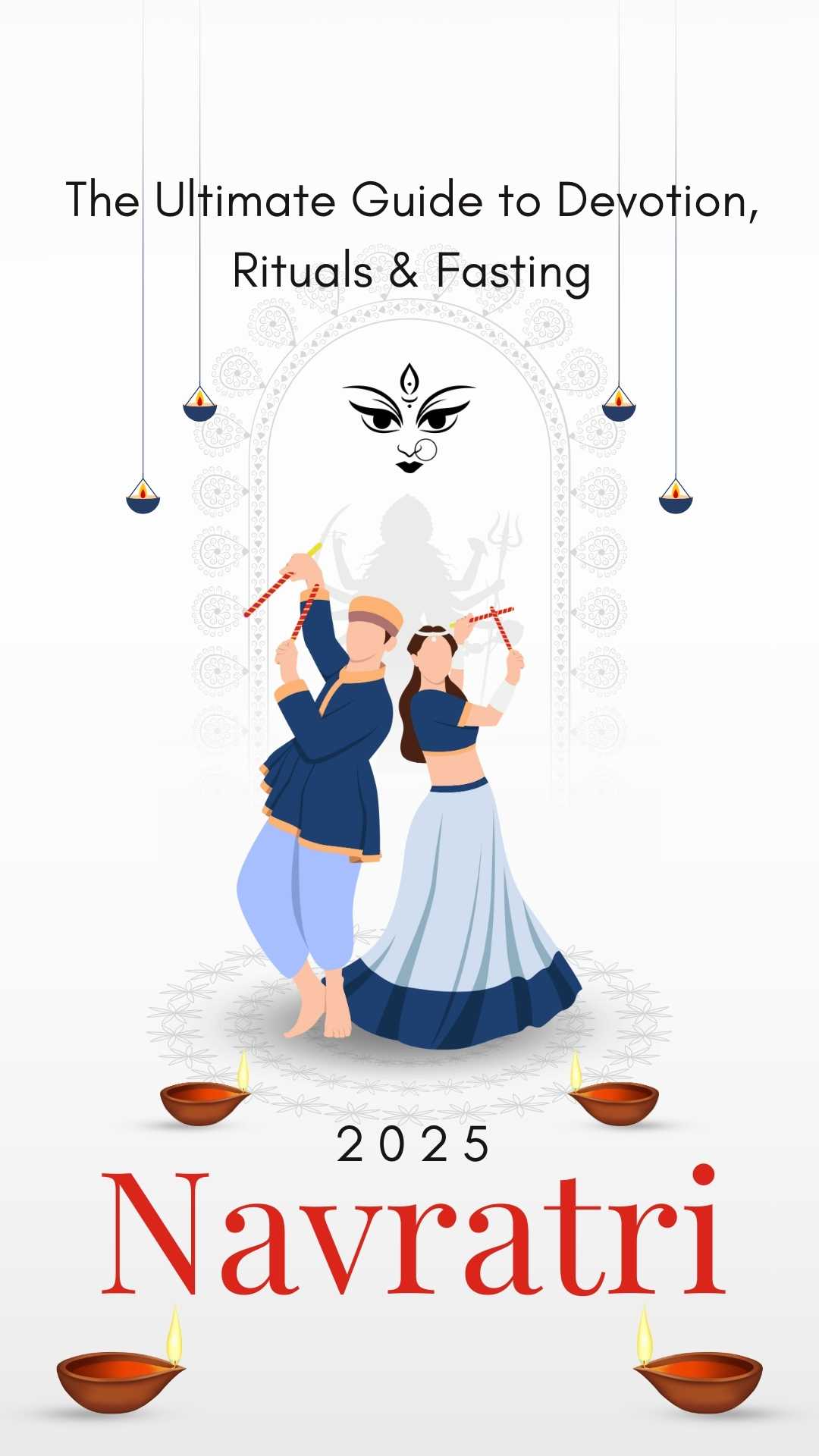Maha Ashtami, the eighth day of Navratri, is one of the most sacred and powerful days in the Hindu festival calendar. Falling on Tuesday, September 30, 2025, Maha Ashtami 2025 marks a day of intense worship for Goddess Durga, specifically her form as MahaGauri, the embodiment of purity and serenity. It is a day filled with devotional zeal, ritualistic richness, and deep spiritual significance, especially celebrated during Navratri and Durga Puja.
This comprehensive guide covers the rituals of Maha Ashtami—focusing on the profound Kumari Puja and Sandhi Puja—along with the auspicious timings (muhurat), fasting rules, spiritual meanings, and its connection to the broader Navratri and Durga Puja festivities.
Also Read – Festival in October 2025: Complete List of Hindu Festivals
Understanding Maha Ashtami: The Eighth Day of Navratri
Maha Ashtami is observed with great fervor across India, particularly in states like West Bengal, Gujarat, Maharashtra, and Odisha. It is renowned as the day when Goddess Durga assumed her fiercest form to destroy the demons Chanda, Munda, and Raktabija, symbolizing the annihilation of evil and negativity.
The day celebrates the power of Goddess Durga to protect, purify, and empower her devotees. Maha Ashtami sits at the spiritual cusp of Navratri, heralding the imminent victory celebrated on Navami and Vijayadashami.
Table of Contents
- What is Maha Ashtami?
- Maha Ashtami 2025: Date, Tithi, and Muhurat
- Spiritual Significance of Maha Ashtami
- Maha Ashtami Puja Vidhi: Step-by-Step Guide
- Kumari Puja: Worship of the Living Goddess
- Sandhi Puja: The Moment of Divine Triumph
- Essential Fasting Rules on Maha Ashtami
- Regional Celebrations Across India
- Maha Ashtami in the Context of Navratri and Durga Puja
- Cultural Practices and Festive Activities
- Symbolism of Goddess Durga’s Fierce Forms
- Fasting Insights: Beyond Physical Abstinence
- Regional Celebrations: Diverse Customs and Social Fabric
- Spiritual Lessons from Maha Ashtami for Devotees
- Practical Tips for Observing Maha Ashtami in Modern Times
- Embracing the Divine Feminine Energy of Maha Ashtami
1. What is Maha Ashtami?
Maha Ashtami is the grand penultimate day of Navratri, dedicated to worshipping Goddess Durga in her fiercest form. The day commemorates her slaying of the powerful demons Chanda, Munda, and Raktabija, symbols of negativity and evil forces. This victory is celebrated with devotion and spiritual zeal, emphasizing the victory of righteousness (dharma) over evil (adharma).
2. Maha Ashtami 2025: Date, Tithi, and Muhurat
- Date: Tuesday, September 30, 2025
- Ashtami Tithi Begins: Monday, September 29 at 4:31 PM
- Ashtami Tithi Ends: Tuesday, September 30 at 6:06 PM
- Sandhi Puja Muhurat: The transitional period between Ashtami and Navami, usually around late morning to early afternoon on September 30 (specific times depend on location)
During these auspicious time windows, performing Puja invokes maximum blessings and spiritual benefits.
3. Spiritual Significance of Maha Ashtami
Maha Ashtami symbolizes the fierce and protective power of the Divine Mother. It is believed the Goddess assumes her most formidable form to destroy all negative forces and restore cosmic balance.
Devotees pray for protection from evil influences, inner strength, mental clarity, and spiritual upliftment. The day also highlights the divine feminine energy as the source of creation, preservation, and destruction in the universe.
In West Bengal and eastern states, Maha Ashtami is the apex of Durga Puja celebrations, attracting millions of devotees to beautifully decorated pandals with artistic idols.
4. Maha Ashtami Puja Vidhi: Step-by-Step Guide
- Preparation: Clean the puja space; arrange Goddess Durga’s idol or image. Decorate with flowers, lamps, and auspicious symbols.
- Invocation (Avahana): Chant Durga mantras to invite the Goddess’s presence, presenting offerings of coconut, banana, haldi, kumkum, and red hibiscus flowers.
- Pushpanjali: Offer flowers and rice grains to the Goddess’s feet while chanting hymns like Durga Saptashati.
- Kumari Puja: Worship young girls symbolizing Durga, applying tilak and offering traditional food.
- Ayudha Puja (in South India): Clean and worship tools, books, and instruments as embodiments of divine energy.
- Sandhi Puja: Perform the sacred ritual at the juncture of Ashtami and Navami with lighting 108 oil lamps, offering pumpkins as symbolic sacrifice, and chanting powerful mantras.
- Arati: Conclude with the lamp ritual, ringing bells, and singing hymns to welcome divine blessings.
5. Kumari Puja: Worship of the Living Goddess
Kumari Puja is a highlight of Maha Ashtami where unmarried young girls (typically between 2 to 10 years old) are revered as living incarnations of Goddess Durga. The ritual includes washing their feet, applying sandalwood paste and vermilion (tilak), tying sacred threads, and presenting gifts and traditional food (puri, chana, halwa). This puja emphasizes purity, feminine power, and the continuity of divine energy among humanity.
6. Sandhi Puja: The Moment of Divine Triumph
Sandhi Puja is a crucial ritual performed at the precise moment when Ashtami tithi transitions to Navami, symbolizing Goddess Durga’s fierce transformation into Chamunda to kill the demons Chanda and Munda. This ritual lasts approximately 48 minutes and involves lighting 108 lamps, chanting verses from the Devi Mahatmyam, and offerings of sacred items.
Devotees believe that Sandhi Puja bestows exceptional spiritual merit, protection, and the removal of obstacles.
7. Essential Fasting Rules on Maha Ashtami
Fasting is an important practice observed to purify the body and mind. Guidelines include:
- Abstain from grains like wheat and rice during the fast.
- Consume vrat-allowed foods such as buckwheat, water chestnut, amaranth, and millets.
- Avoid onions, garlic, non-vegetarian food, and tamasic substances like alcohol.
- Drink milk, eat fruits, nuts, and vrat-special dishes including sabudana khichdi.
- Observe partial or full fasting depending on personal and regional customs.
Fasting on Maha Ashtami is believed to appease Goddess Durga and invite her blessings.
8. Regional Celebrations Across India
- West Bengal & Eastern India: Maha Ashtami is the main day of Durga Puja, with large artistic pandals, cultural programs, and festive gatherings.
- South India: Ayudha Puja (tool worship) and Saraswati Puja coincide with or follow Maha Ashtami, incorporating unique regional traditions.
- Western and Northern India: Communities hold special pujas, devotional singing, and fasts, aligning with broader Navratri festivities.
9. Maha Ashtami in the Context of Navratri and Durga Puja
Maha Ashtami is part of Navratri’s spiritual journey, highlighting one of the goddess’s fiercest days. Durga Puja festivals across India celebrate her various forms during this period, with Maha Ashtami often marking their crescendo in devotion and celebration.
The following days, Maha Navami and Vijayadashami, signify the goddess’s victory and the message of dharma’s triumph, linking Maha Ashtami to the larger narrative of righteousness prevailing.
10. Cultural Practices and Festive Activities
Many regions celebrate Maha Ashtami with folk dances like Garba and Dandiya; musical concerts, drama performances showcasing Durga’s stories; and community feasting. These activities add color, joy, and social bonding to the sacred observances.
Symbolism of Goddess Durga’s Fierce Forms
On Maha Ashtami, Durga’s complex nature is especially venerated. She embodies paradoxes—a benevolent mother and a fierce warrior. Her weapons represent the power to cut through ignorance, ego, and malice. Her lion mount symbolizes fearlessness and strength.
The myth of Raktabija (whose drops would spawn new demons) teaches devotees about the importance of mindful actions and purification. Durga’s victory reveals the triumph of divine will over repeated negativity.
Understanding Each Step
Preparation Before Maha Ashtami
Devotees meticulously prepare their homes and puja venues, ensuring cleanliness and sanctity. Preparation includes setting up colorful rangoli, decorating spaces with marigold and hibiscus flowers—especially the red hibiscus sacred to Durga.
Sacred items like turmeric, vermilion, holy water, and sandal paste are arranged. Special fast-friendly meals and offerings are prepared in advance.
The Morning Ablutions and Invocation
Beginning with a bath and wearing traditional attire (often red or yellow, associated with the goddess), devotees start the puja in the early morning. The chanting of mantras creates a devotional atmosphere as they invoke the goddess’s presence with fragrant incense and light.
Kumari Puja: Honoring the Living Devi
Multiple rituals in Kumari Puja signify different meanings:
- Washing of Feet: Symbolizing purification and welcoming the divine.
- Applying Kumkum and Sandalwood: Expressing respect and invocation of auspiciousness.
- Offering Vrat Food: Sharing sacred food to bless the living goddess and seek her blessings for fertility, wisdom, and protection.
- Presentation of Gifts: Emphasizes community care, nurturing the next generation, and honoring feminine divinity.
Sandhi Puja: The Spiritual Heart and Intense Worship
This ritual marks the exact time of cosmic change when the goddess transitions from Durga to Chamunda. The fire ceremonies (homas), ringing of bells, recitation of Devi Mahatmya, and offering rice, pumpkin, and other items to flames, symbolize the destruction of evil aspects within and without.
Sandhi Puja’s spiritual importance is widely recognized for its transformative power, as it is believed to remove negative karmas and protect the household from evil influences.
Evening Aarti and Bhog Offering
The evening aarti is a devotional climax, inviting family and community participation. It involves rhythmic ringing of bells, swirling of camphor lamps, and singing devotional songs praising Durga’s virtues.
Bhog or prasad includes sweet and savory items such as khichdi (lentils and rice), labra (mixed vegetable curry), fruits, and sweets like sandesh or rasagulla in Bengali traditions.
Fasting Insights: Beyond Physical Abstinence
Fasting during Maha Ashtami is not merely physical but a spiritual detoxification. It heightens awareness, promotes discipline, and harmonizes mind and body for better spiritual connection.
Strategies include:
- Hydration: Adequate water and herbal teas help maintain energy.
- Balanced Nutrition: Use vrat recipes rich in protein, vitamins, and minerals.
- Mindful Eating: Observing fast with gratitude and devotion enhances benefits.
Regional Celebrations: Diverse Customs and Social Fabric
Each Indian region enlivens Maha Ashtami with distinct customs:
- Bengal: Elaborate pandal processions, thematic decorations, and community feasts.
- Gujarat and Maharashtra: Traditional dances (Garba and Dandiya), family gatherings, and municipality-organized pujas.
- South India: Ayudha Puja coincides with Maha Ashtami, worshipping tools and vehicles.
- North India: Community chanting, fasting, and regional folk performances.
Spiritual Lessons from Maha Ashtami for Devotees
Maha Ashtami teaches:
- Resilience: Like Durga, to confront life’s hurdles with courage.
- Balance of Power and Compassion: Embodying strength tempered by kindness.
- Spiritual Awakening: Recognizing the divine feminine as a source of creation and sustenance.
Practical Tips for Observing Maha Ashtami in Modern Times
- Setting Intentions: Start the day with personal prayers focused on overcoming personal negativities.
- Community Participation: Join or visit local Navratri or Durga Puja events to enhance communal joy.
- Meditation and Mantra Chanting: Incorporate chanting or meditation sessions focusing on Durga’s energy.
- Decor and Puja Setup: Use eco-friendly materials, fresh flowers, and traditional lamps to create a sanctified space.
Embracing the Divine Feminine Energy of Maha Ashtami
Maha Ashtami 2025 offers vibrant opportunities for devotion, introspection, and cultural participation. Celebrating with mindfulness enriches the body, mind, and soul, enabling devotees to internalize Goddess Durga’s strength and protection.
Let this Maha Ashtami inspire all to triumph over their challenges with grace, courage, and unwavering faith in the divine.


